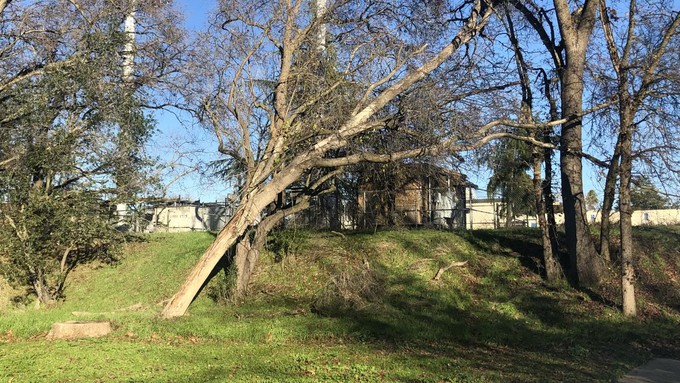
Watch for falling trees and branches

A park tree leans precariously after last weekend's storm. The sun was (briefly) out when it was photographed, but the tree could be in danger of falling during the next windy storm, starting Wednesday. Avoid driving or walking under trees if possible. Kathy Morrison
More wild weather is headed for Sacramento. And with this next round of rain come some powerful winds – and that could represent some real danger to our homes and gardens.
“Damaging winds will impact the region Wednesday and Thursday,” tweeted the Sacramento office of the National Weather Service. “Gather emergency supplies, charge your electronic devices, use generators outdoors, and keep refrigerators closed.”
In other words, be ready for more power outages due to downed power lines – and trees.
On Tuesday afternoon, the weather service issued a High Wind Warning for the greater Sacramento area, in effect from 10 a.m. Wednesday to 4 p.m. Thursday. That’s also when Sacramento can expect another inch or two of rain.
“Damaging winds will blow down trees and power lines,” says the wather service. “Widespread power outages are expected. Travel will be difficult, especially for high-profile vehicles.
“Saturated soils will allow trees to topple more easily during this wind event,” adds the warning. “The strongest winds will be Wednesday afternoon and into Thursday morning.”
Southerly winds will blow steadily from 25 to 30 mph, with gusts of 60 mph, predicts the weather service.
If you haven’t already, tie down or move anything that can be blown around by such gusts. Patio furniture can become missiles. Hanging plants can bash into windows. Large potted plants will be knocked over and rolled around.
Most destructive are falling branches and uprooted trees. The weather service warns residents to stay away from trees during this storm – and away from windows that could be broken.
Evergreen trees such as redwoods or cedars are at greater risk. Their foliage acts like a giant sail and catches the wind’s full force.
Before the storm, survey trees and large shrubs in your own landscape. Young trees may be stabilized with stakes or other supports; otherwise, their trunks and limbs may snap during this storm. More mature trees may need professional help.
For tips on tree care – before and after this storm – and how to hire an arborist, go to www.sactree.org.
For more on wind damage, consult these UC master gardener notes: https://ipm.ucanr.edu/PMG/GARDEN/ENVIRON/wind.html
-- Debbie Arrington
Comments
0 comments have been posted.Sacramento Digs Gardening to your inbox.
Food in My Back Yard Series
April 29: What's (already) wrong with my tomato plants?
April 22: Should you stock up on fertilizer? (Yes!)
April 15: Grow culinary herbs in containers
April 8: When to plant summer vegetables
April 1: Don't be fooled by these garden myths
March 25: Fertilizer tips: How to 'feed' your vegetables for healthy growth
March 18: Time to give vegetable seedlings some more space
March 11: Ways to win the fight against weeds
March 4: Potatoes from the garden
Feb. 25: Plant a fruit tree now -- for later
Feb. 18: How to squeeze more food into less space
Feb. 11: When to plant? Consider staggering your transplants
Feb. 4: Starting in seed starting
Sites We Like
Garden Checklist for week of May 4
Enjoy this spring weather – and get gardening!
* Plant, plant, plant! It’s prime planting season in the Sacramento area. Time to set out those tomato transplants along with peppers and eggplants. Pinch off any flowers on new transplants to make them concentrate on establishing roots instead of setting premature fruit.
* Direct-seed melons, cucumbers, summer squash, corn, radishes, pumpkins and annual herbs such as basil.
* Harvest cabbage, lettuce, peas and green onions.
* In the flower garden, direct-seed sunflowers, cosmos, salvia, zinnias, marigolds, celosia and asters. (You also can transplant seedlings for many of the same flowers.)
* Plant dahlia tubers. Other perennials to set out include verbena, coreopsis, coneflower and astilbe.
* Transplant petunias, marigolds and perennial flowers such as astilbe, columbine, coneflowers, coreopsis, dahlias, rudbeckia and verbena.
* Keep an eye out for slugs, snails, earwigs and aphids that want to dine on tender new growth.
* Feed summer bloomers with a balanced fertilizer.
* For continued bloom, cut off spent flowers on roses as well as other flowering plants.
* Add mulch to the garden to maintain moisture. Mulch also cuts down on weeds. But don’t let it mound around the stems or trunks of trees or shrubs. Leave about a 6-inch to 1-foot circle to avoid crown rot or other problems.